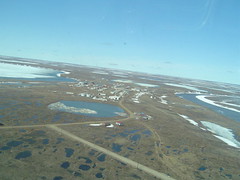I wish I’d been able to ask the driver more questions, but by the time I finished taking pictures of the rollagons from every conceivable angle, my face was so cold that I was having a hard time getting words to come out right. I hope he didn’t think I was TUI (talking under the influence)…that’s an embarrassing thought.
A couple of days ago someone told me that the tires on a rollagon are actually soft and pillow-like. There is supposed to be a photo or advertisement somewhere that shows a woman lying on a beach being run over by a rollagon without physical damage or discomfort to her body. I asked the driver if the tires were actually soft and pillow-like. He looked at me blankly for a minute. Then his mouth curled into one of those you-poor-gullible-soul smiles and he said, “Uh…” So, I’m guessing that would be a no.
One of the trickiest anomalies of the Arctic is conflicting information. Equally reasonable and seemingly knowledgeable people can have two entirely different perceptions of the same event and pass on mutually exclusive information as indisputable fact. It’s often a challenge to determine if something I’ve heard is actually true or just true enough.
******************
After seeing the rollagons for myself, I realized that the description found here describes exactly what you'll see in these photos. (and the photo from the previous post is not)

When I walked around to the far side of the trucks, I noticed a spare tire wedged in beside the tank and below the trailer there was yet another tire attached to some sort of arm that looked as if it could extend outward. When I read the article about rollagons it mentioned a "fifth set of tires installed under its cargo dock. That difference raises the vehicle's payload capability by 15,000 pounds, to 45,000 pounds." I'm thinking that must explain it. Anyone have a better theory? I'm open to ideas. This is the Arctic, after all. Our explanations don't have to be actually true...just true enough! :)











































